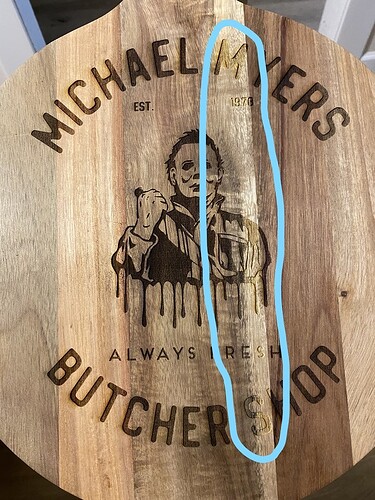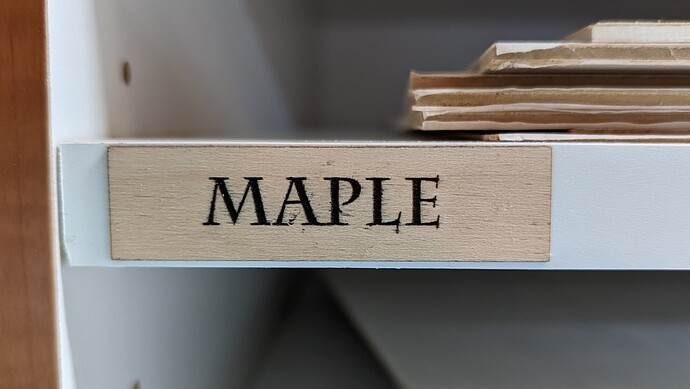So I ran into a situation engraving the cutting board. Everything went well until I got to the section that had a lighter wood color. I’m thinking I can use a wood stain marker to darken it in to be the same or close to. After that’s done I’d seal it with a poly coat so it would stay. Am I thinking correctly? Any help would be great.
Worth a shot .
One thing to keep in mind, the laser opens the wood grain and capillary action may draw the pigment into the fibers. Guess how I know that.
The way I have avoided bleed when coloring engravings on cutting boards (with food dye and a paint brush) is to score deeply all around the engraving. That keeps the color from reaching out to the adjacent wood. Of course, once you remove the item from the GF bed, you can’t do this.
Fundamentally, that’s just how wood works - differences in density produce different engrave results. That’s why uniform veneers on plywood look so much better. Bamboo is another problem material.
Had the same problem when engraving Maple tap handles. Found that acrylic paint worked much better.
So if I used the acrylic paint on it would I have to use it on all of the engraving then seal it? Also am I going to have to mask off everything else in order to do this?
No need to seal it, as you should not use engraved side for food anyway.
Engraved cutting boards are for decoration.
Beat me to it. Was going to say that too.
I engrave small wooden pieces with my signature on them and glue them to the finished boards I make, these will take the oil / beeswax mixture I use on the whole board. That’s the only thing I’ve engraved and typically will use Walnut when doing that. Would never consider “sealing” a cutting board and then using it as you’re begging for disaster.
I’ve made several for friends and told them, use the back side if you must, otherwise it’s just for decoration.
I have a “brand” that I like to use but that makes the back side unusable as well.

Honestly I never considered engraving mine at all. I’m typically making end grain ones (I’ve made about 20 now) with different species and they’re all 2" x 12" x 18". Never tried to fit one in the GF, but they’re too beautiful to do anything but oil and wax them.
Like I said for decoration. I get cheap bamboo boards. I’ve never engraved one for myself.
My real cutting boards will never see the laser.
What’s your favorite species to use? Currently, I’m using maple, paduk, walnut, purple heart and cherry. I’ve tried a few with scraps from our new floors (acacia) and it looks cool, but the end grain never softens and it’s always rough, which is weird.
For the stuff I’ve made for friends, I just use cheap bamboo and heavy settings to get a good contrast.
I honestly don’t know what my real cutting boards are made from but they were not cheap. I only have two, and one of them retailed for over $200. I did not pay that, I was dating someone in the business.
I have two, because one of them has those recesses to catch meat juices. The other is completely flat.
I have not used it myself yet, but picked this stuff up for masking and painting engravings after seeing a video on YouTube for engraving and painting signs. The vinyl masks off the rest of the wood, so you don’t paint outside the engraving. However, as others have said, need to watch out for bleed. https://amzn.to/3AURJGa
Ok everyone I thank you for the input!! I am going to probably fill in the engrave with acrylic paint and call it a day.
Suggestion… Use the board that you think is already ruined as a test piece. Won’t make you happy to use a new board and find out the paint still bleeds.
Unless you coat it with a food safe epoxy resin. But then you shouldn’t cut on it. Just serve.
Juice groove
This topic was automatically closed 30 days after the last reply. New replies are no longer allowed.

